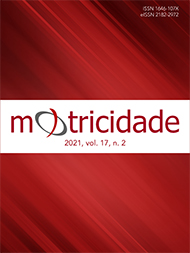Low aerobic fitness among adolescents: prevalence and associated factors
DOI:
https://doi.org/10.6063/motricidade.19951Keywords:
cardiorespiratory fitness, students, adolescent health, runningAbstract
It was our objective to estimate the prevalence and associated factors with low aerobic fitness among adolescents. A cross-sectional study was conducted with 575 subjects aged 11–17 years from Criciúma, SC, Brazil. The 9-minute walk/run test was used to assess aerobic fitness. Sociodemographic data and daily habits were collected using a self-administered questionnaire. Anthropometric evaluation was also performed to calculate anthropometric indicators of obesity. The Chi-square test and the binary logistic regression were used. The prevalence of low aerobic fitness in boys aged 11–13 years was 46.0% and in girls 40.5% (p<0.05), while in boys aged 14–17 years, the prevalence was 59.6% and in girls 46.6 % (p<0.05). Boys aged 11-13 (OR: 5.04; 95% CI: 1.93–13.17) and those aged 14–17 years (OR:3.78; 95% CI: 1.90–7.52) and girls aged 11-13 years (OR: 3.62; 95% CI: 1.24–10.52) from private schools were about four times more likely of having low aerobic fitness compared to those from public schools. Girls aged 11-13 years (OR: 2.40; 95% CI: 1.04–5.54) with inadequate sleep were more likely to have low aerobic fitness than those with adequate sleep. High prevalence of low aerobic fitness was associated with private schools and inadequate sleep in both sexes.
KEYWORDS: cardiorespiratory fitness; students; adolescent health; running.
Downloads
Published
Issue
Section
License
The authors of submitted manuscripts must transfer the full copyright to Journal Motricidade / Sílabas Didáticas Editions. Granting copyright permission allows the publication and dissemination of the article in printed or electronic formats, and copyrights start at the moment the manuscript is accepted for publication. It also allows Journal Motricidade to use and commercialise the article in terms of licensing, lending or selling its content to indexation/abstracts databases and other entities.
According to the terms of the Creative Commons licence, authors may reproduce a reasonable number of copies for personal or professional purposes, but without any economic gain. SHERPA/RoMEO allows authors to post a final digital copy (post-printing version) of the article on their websites or on their institutions' scientific repository.


